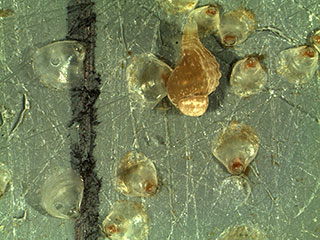Posted on UC Davis News: 16 Jan 2013 — The once-booming, now struggling Olympia oyster native to the West Coast could face a double threat from ocean acidification and invasive predators, according to new research from the University of California, Davis’ Bodega Marine Laboratory.
A juvenile snail preying on newly settled Olympia oysters. The clear oyster shells on the left have been drilled by the snail. Snails consume oysters at a faster rate under acidified conditions. (Photo Credit: Eric Sanford, UC Davis)
The work is published Jan. 15 in the journal Proceedings of the Royal Society B.
Invasive snails ate 20 percent more juvenile oysters when both oysters and snails were raised under ocean conditions forecast for the end of this century, the researchers found. The results highlight the dangers of multiple stressors on ecosystems, said Eric Sanford, professor of evolution and ecology at UC Davis and first author on the study.
“You might decide to go to work if you had a toothache. But what if you had a toothache, the flu, and a broken leg? At some point, multiple stressors will cause natural systems to break down,” he said.
Native Olympia oysters were once so common in San Francisco Bay that they were a cheap food during the Gold Rush, commemorated in Hangtown Fry, an omelet of eggs, bacon and oysters. The population collapsed from overfishing in the late 1800s and has never recovered.
Atlantic oysters imported to the West Coast brought predatory snails such as the Atlantic oyster drill, which uses acid and a rasping tongue to drill holes in oyster shells.
Scientists have become increasingly concerned about the effects of climate change on ocean chemistry. As heat-trapping carbon dioxide builds up in the atmosphere, some of the gas dissolves in the oceans, causing a steady rise in the overall acidity of the oceans. An interdisciplinary team of researchers based at UC Davis’ Bodega Marine Laboratory is looking into the oceans’ future by raising animals in seawater with raised levels of dissolved carbon dioxide. In earlier work, they found that oysters raised under conditions predicted for the end of this century are smaller than present-day animals.
In Tomales Bay north of San Francisco, young snails emerge from egg capsules at about the same time of year that juvenile oysters settle from the plankton and grow into adults. Sanford and colleagues raised both oysters and snails in the lab to simulate this process under present-day conditions and with levels of carbon dioxide forecast for 2100.
They found that oysters raised under high carbon dioxide were smaller, but did not have thinner shells than oysters reared under present-day conditions. The snails were not affected by high carbon dioxide, but ate 20 percent more oysters under these conditions.
“It’s like if you go out for tacos,” Sanford said. “If the tacos are smaller, you’re going to eat more of them.”
The experiment was based on the average acidity of the oceans. However, as the overall acidity of the ocean rises, short-term fluctuations mean that locations like Tomales Bay are already experiencing peaks of acidity similar to those used in the experiment.
Apart from their culinary delights, oysters perform important ecosystem services, for example filtering material out of the water, and there have been growing efforts to restore their populations along the West Coast, including in San Francisco Bay. But the new work shows that the combination of climate change and invasive predators may make restoration increasingly difficult.
Co-authors on the study are: Professor Brian Gaylord, graduate student Annaliese Hettinger and researcher Elizabeth Lenz, Department of Evolution and Ecology and Bodega Marine Lab; Professor Tessa Hill, Department of Earth and Physical Sciences and Bodega Marine Lab; and Kirstin Meyer, undergraduate student at Northern Michigan University. The work was funded by the National Science Foundation.
About UC Davis
For more than 100 years, UC Davis has been one place where people are bettering humanity and our natural world while seeking solutions to some of our most pressing challenges. Located near the state capital, UC Davis has more than 33,000 students, over 2,500 faculty and more than 21,000 staff, an annual research budget of over $750 million, a comprehensive health system and 13 specialized research centers. The university offers interdisciplinary graduate study and more than 100 undergraduate majors in four colleges — Agricultural and Environmental Sciences, Biological Sciences, Engineering, and Letters and Science. It also houses six professional schools — Education, Law, Management, Medicine, Veterinary Medicine and the Betty Irene Moore School of Nursing.
Additional information:
Media contact(s):
- Eric Sanford, Bodega Marine Laboratory, (707) 875-2040, edsanford@ucdavis.edu
- Andy Fell, UC Davis News Service, (530) 752-4533, ahfell@ucdavis.edu
Access the Abstract:
Ocean acidification increases the vulnerability of native oysters to predation by invasive snails
There is growing concern that global environmental change might exacerbate the ecological impacts of invasive species by increasing their per capitaeffects on native species. However, the mechanisms underlying such shifts in interaction strength are poorly understood. Here, we test whether ocean acidification, driven by elevated seawater pCO2, increases the susceptibility of native Olympia oysters to predation by invasive snails. Oysters raised under elevated pCO2 experienced a 20% increase in drilling predation. When presented alongside control oysters in a choice experiment, 48% more high-CO2oysters were consumed. The invasive snails were tolerant of elevated CO2 with no change in feeding behaviour. Oysters raised under acidified conditions did not have thinner shells, but were 29–40% smaller than control oysters, and these smaller individuals were consumed at disproportionately greater rates. Reduction in prey size is a common response to environmental stress that may drive increasing per capita effects of stress-tolerant invasive predators.
Sanford E., Gaylord B., Hettinger A., Lenz E. A., Meyer K. & Hill T. M., 2014. Ocean acidification increases the vulnerability of native oysters to predation by invasive snails. Proceedings of the Royal Society B: Biological Sciences 281(1778):2013-2681. Article.
